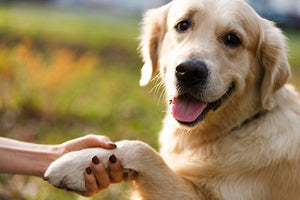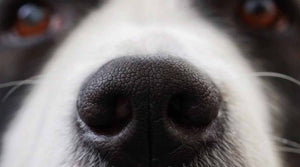Your Cart is Empty
💗FREE shipping on Oprah's Favorite Dog Walking Bag! Everything ships FREE on orders over $30 💗
💗FREE shipping on Oprah's Favorite Dog Walking Bag! Everything ships FREE on orders over $30 💗
💗FREE shipping on Oprah's Favorite Dog Walking Bag! Everything ships FREE on orders over $30 💗
💗FREE shipping on Oprah's Favorite Dog Walking Bag! Everything ships FREE on orders over $30 💗
Add description, images, menus and links to your mega menu
A column with no settings can be used as a spacer
Link to your collections, sales and even external links
Add up to five columns
Add description, images, menus and links to your mega menu
A column with no settings can be used as a spacer
Link to your collections, sales and even external links
Add up to five columns
February 01, 2022 10 min read
Though dogs are born with tenacious paw pads, they still succumb to cracking just like human heels, and even more so with drier hot weather outdoors - and in dried out air conditioned indoor air!
Not only are dry cracked dog paws unsightly, but they can also make life super-uncomfortable for your pup if not taken care of early with a good, high quality paw balm such as Pup Wax® which is made from organic, clean ingredients that soothe and heal dry and cracked paw pads.
So in this ultimutt guide - we'll cover the reasons why your dog might be experiencing dry, cracked paws and what the best course of action is for you and your pup!
Specifically, we’ll look at:
Read on for our step-by-step instructions to help your pup find relief and stop chewing and licking their paws.
How are dry cracked dog paws diagnosed?
It is easy to check for cracked paws right at home. You may also schedule a vet appointment to have your dog’s paws checked.
How best to treat your pup for cracked paws depends on the severity of the condition.
In mild cases, getting rid of irritants and applying a good paw wax balm such as Pup Wax® on the affected surface takes care of the problem.
In severe cases, you may have to bandage the paw and restrict your dog's movement for a while.
Let's go through the process step-by-step.

Step #1: Clean the paw
Cleaning the paw ensures that debris, germs, bacteria, and viruses are removed from the cracked pad. Use a saline solution to disinfect the pad before wiping it. Do not use hydrogen peroxide as it is too strong and can cause damage to skin tissue.
Step #2: Address visible cuts
Check your dog's paw for any visible cuts. If the cuts run deep, let a professional vet stitch up the paw. Some vets also recommend applying superglue to visible cut. Apply the glue on the cut then press the area together until it dries. This works just like stitching and prevents the cut from festering. Let your vet give the go-ahead to use over-the-counter glue in place of surgical glue.
Step #3: Apply a high quality paw wax balm such as Pup Wax®
There are plenty of wax balm products on the market today. Though they may moisturize a dry cracking paw pad, they usually contain cheap fillers and other harmful ingredients, that may cause more health problems for your pup over time. Pup Wax® balms soothe and moisturize dry cracking paw pads using only high quality and clean ingredients. They consist of barrier formulas that add a layer of protection over the affected area to prevent further damage.
Dog Care Products:The Good, Bad, And The Ugly
Dog care products come in all shapes and sizes. Some of these have more dangerous ingredients than you’d imagine.
Always go the organic route when considering wax balms for dry cracked dog paws. Read through the ingredients and confirm there are no toxins or damaging ingredients in the product. It is best to use products without mineral oil, cocoa butter, comfrey, tea tree oil, wintergreen oil, ylang ylang, petrolatum, or paraffin wax. We also recommend avoiding balms with perfumes and fragrances, which are irritating to pup's sensitive noses. The wax balm you choose should not only moisturize dry paw pads but also carry healing properties that directly benefit your dog.
Fortunately, there are plenty of organic wax balms on the market that effectively address the issue of dry cracked dog paws. One such product is Pup Wax® which, includes only natural ingredients that soothe and heal dry and cracked paw pads.

We use only the best ingredients in our Pup Wax® paw balms for dry cracked dog paws including:
Organic Fair Trade Certified Shea Butter
Organic Beeswax
Organic Virgin Coconut Oil
Organic Argan Oil
Organic Hempseed Oil
Candelilla Wax
When treating your dogs for dry, cracked dog paws, we’d recommend scouting out the following ingredients:
Shea butter
Derived from whole shea butter seeds, it acts as a natural moisturizer that soothes dry paw pads. Organic shea butter has a thick consistency that helps retain moisture on your pup's paws. Another health benefit of shea butter is increasing capillary circulation which in turn boosts healing and cell regeneration.
Beeswax
Wax balms with beeswax as an ingredient provide a protective layer over large cracks or cuts on a dog’s paw. Also, beeswax is a natural emollient with anti-inflammatory properties that help reduce skin irritation. Beeswax carries antibacterial and antiviral properties that could heal festered cracked paws.
Virgin coconut oil
There is a plethora of benefits to be found in coconut oil for dogs. Virgin coconut oil is said to improve hotspots and reduce skin irritation. Coconut oil would be perfect for a dog that feels itchy due to external irritants like ice salt. Organic coconut oil also moisturizes and repairs dry damaged skin. If your dog's cracked paws are caused by food allergens, virgin coconut oil will help alleviate the symptoms.
Argan oil
Argan oil contains the antioxidant y-tocopherol which fights free radicals in the skin. This oil also makes the skin lustrous whilst protecting it from malignant growth. If you are looking for a great skin moisturizer and revitalizer, argan oil will do it for your pup. One study has also found that this oil inhibits prostate cancer in dogs. Read more here.
Hempseed oil
Hemp seed oil promotes the vibrancy and elasticity of the skin. As a non-saturated plant-based oil, hemp seed also packs lots of Omega 3 and Omega 6 fatty acids. If your dog's dry cracked paws are as a result of Zinc deficiency, the Omega 3 in hemp seed oil helps replenish this missing mineral.
Candelilla wax
Candelilla wax shares many of the same properties with beeswax and is a great alternative for vegans and vegan dogs. It adds a thick even barrier over the skin which traps moisture and keeps the skin hydrated.

Step #4: Enclose the affected pad
After applying the wax balm, use a bandage to wrap up the affected area. This prevents your dog from further scratching and chewing its paws. You ensure that the balm stays on and your pup does not lick it off its paws.
If you do not have bandages, an old sock would do just fine. Apply the balm before sliding the sock in. Some dogs can be clever and bite or pull the sock off. If your pup tends to be a smart aleck, consider securing the sock with a rubber band to prevent it from slipping off.
Step #5: Use a pet cone
A pup that aggressively scratches and chews on its paws will need a pet cone. When worn around its neck, it prevents the canine from reaching the cracked paws with its tongue and teeth. A cone can provide ample time for the cracks to close up.
Step #6: Bed rest
If the dry cracked dog paws are causing pain or walking issues in your pup, consider putting him on bed rest. Limit his movement until the cracks are fully healed.
There are various reasons why your pup has cracked paws. These paw imperfections are caused by external irritants as well as internal problems like illness. Getting to the bottom of the cause is important so that you can identify the best prevention protocol for your pup. If you notice dry cracked paws on your pooch, it could be one of the following reasons.
1) Food Allergies
Ingredients in food can cause allergic reactions in your pup. One of these reactions is constantly itching in the ears, coat, and paws. Your dog scratches and chews its paws to find relief. In the process, excessive chewing causes dry cracked dog paws.
If allergies are not identified and treated early, the itching becomes persistent. Your dog will constantly chew on its paws making the cracks bigger. This can lead to the rupturing of the capillaries in the paw pads causing bleeding.
2) Wear and tear
Paw pads absorb shock that can damage leg joints. This allows your dog to run, crawl, or jump on any surface without straining or breaking a limb. But constant use of the paw pads leads to wear and tear that causes dry cracked dog paws.
Paw pads can also be quite sensitive, especially in the winter, and in particular for dogs who spend most of their time indoors. The salt products that are used as ice melt on sidewalks and roads in the winter cause the paw pads to dry up leading to cracking. They are often made of chemicals that are toxic to dogs, but which are absorbed by the paw pads with extended exposure. In warmer regions or times of the year, if your pup stands on hot asphalt for too long, they may also end up with cracked paws.
3) Contact with surface irritants
Besides ice salt, other surface irritants can cause your dog's paws to crack. Chemicals in carpet cleaners and garden sprays irritate the paw pad making your dog itch and scratch a lot. The constant scratching and chewing of the paws can cause fissures on the paw pads.
4) Diseases
Dry cracked dog paws could also be a result of an underlying disease. An immune disease like hyperkeratosis, which affects senior dogs, causes an influx of keratin on the skin. This causes the paw pads to dry, harden, and crack. Hyperkeratosis also causes the growth of cones on the pads which can hinder your dog's mobility.
Another disease that can lead to dry cracked dog paws is pemphigus. The immune system mistakes the skin cells as a disease-causing pathogen. As skin cells get destroyed, pus-filled blisters form on the paw pads which burst and leave a dried crust. If not addressed, Pemphigus
can spread to the nose and ears.
Dried cracked dog paws can also stem from the formation of a hard skin layer known as a callous. A callous will form over an area of skin that is subject to hard impacts like the paw pad. Repeated impact on the pads makes the callous harden, dry and crack.
If your dog has dry and cracked paw pads, you should have them checked for hard-pad disease. This condition causes the paw pads to swell and crack. Hard pad disease is prevalent in pups that are recovering from distemper.
5) Mineral deficiency
Dry cracking paw pads can be a sign of zinc deficiency in dogs. A poor diet can result in zinc deficiency which causes the paw pads to thicken and harden. This makes them vulnerable to drying and cracking. Some dog breeds are more susceptible to zinc deficiency compared to others. They include the Siberian Husky, German Shepherd, Samoyed, and Great Danes. Poodles and Beagles are at risk as well.
Now that your dog is treated for dry and cracked paws, you'll want to establish a maintenance skincare routine for their paws to prevent the condition from recurring.
These tips should help prevent any future problems with cracked paws:
Dry cracked dog paws can be unsightly and uncomfortable to your pup. Fortunately, there are ways to treat or improve the condition as well as prevent any future breakouts. Take your dog to a professional vet to be checked. Use over-the-counter medication to treat any underlying disease that is causing cracked paws. If the problem is external, there are plenty of natural ingredients that will heal, moisturize, and revitalize the paw pads.
Shop Pup Wax® now for happy paws and happy pups! Click here to get started.
Was this blog post helpful?
Please use the links below to share and then sign up for our newsletter to keep up-to-date with the latest tips and information from Puppington.



Comments will be approved before showing up.